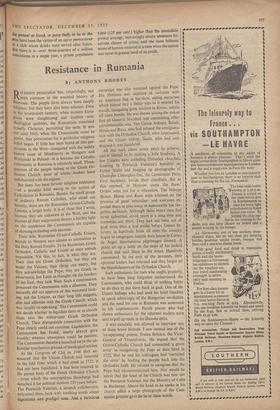'This Happy Breed'
By HENRY KERBY, MP OCIOLOGISTS will derive little comfort from a the latest Blue Book on Criminal Statistics, England and Wales, 1956, for if the majority of wage-earners have never had it so good, the majority of warders have never had 'em so full. And three to a cell invites comparison with New' gate. The facts set out so coldly in this Blue Book reflect little credit on our educational system.
In 1956 cases of `Murder, attempted murder, and threats or conspiracies to murder' were 50 per cent. higher than the 1935-39 average. There were rather more than one daily. Convictions for cruelty to children have doubled, for incest they have trebled, and for 'indecency with males' there were seven times as many convictions in 1956 as in 1935-39 (average).
Using the same years for comparison, brothel- keeping convictions remained steady : but black- mail was up 28 per cent., sacrilege 100 per cent., and indecent exposure 50 per cent. While con- victions for 'living on prostitutes' earnings' fell from 225 in 1935-39 to 136 in 1956, proven offences by individual prostitutes quadrupled. On the basis of a seven-day week (not limited to 40 or even 48 hours} this class of ,offence averaged 35 daily all through the year, including Bank Holidays. Even those figures give no real indica- tion of the number of women engaged in this trade. Yet nobody pretends to have a solution beyond increasing fines and raising the prison population still higher.
There has been a slump in poaching, both by day and by night, for what that is worth, but offences against the Wild Birds Protection Acts have gone up by half. Prosecutions for gaming fell sharply; perhaps football pools, Premium Bonds and the Stock Exchange, all requiring more skill and less nerve than faro, roulette and c/winin de fer, are contributory causes of the decline in gaming convictions. It is, however, a tribute to the Welfare State that offences against the Ped- lars Acts are but one-tenth of what they were before the war.
Yet when all is said and done the total number of persons found guilty of indictable offences in 1956 was 784,197, which is another way of saying that the entire population of—say—Liverpool was embraced by the police in the course of those twelve months. True enough, more than half were traffic offenders. Nevertheless, a traffic offence is a crime according to the law. But what is the most alarming feature of these recent statistics? It is the increase in the number of offenders in the 14 to 17 age group. It is the proportion of crimes by youth resulting from lust and the urge for material gain, and the shocking increase in violence. Of the non-traffic offenders (42.3 per cent.) 9.3 per cent. were larceners, 1.5 per cent. were prostitutes, 7.9 per cent. were offenders against the liquor laws, and 1.8 per cent. fell foul of the Gaming and Betting Acts.
It is a sobering (or should it be intoxicating?) thought that of the 56 passengers (no standing) on a fully loaded double-decker bus at least one was convicted as a criminal in 1956. And this at a time of full employment, when only the over- forties need fear unemployment and youth was never so well rewarded for its work. Your fellow passenger may have committed 'a crime against
the person' or fraud, or petty theft, or he or she may have been the victim of an agent provocateur at a club where drinks were served after hours. But there it is—over three-quarters of a million convictions in a single year, a prison population
9,000 (125 per cent.) higher than the immediate prewar average, increasingly severe sentences for certain classes of crime, and the most hideous waste of human material at a time when the nation was never in greater need of its youth.







































 Previous page
Previous page